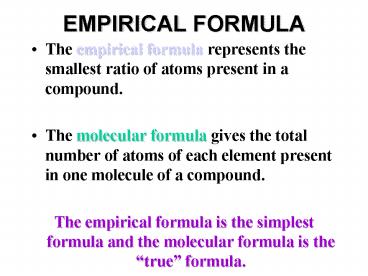EMPIRICAL FORMULA - PowerPoint PPT Presentation
Title:
EMPIRICAL FORMULA
Description:
The molecular formula gives the total number of atoms of ... 3. Determine the empirical formula of a compound that contains 89.7 % bismuth and 10.3 % oxygen. ... – PowerPoint PPT presentation
Number of Views:334
Avg rating:3.0/5.0
Title: EMPIRICAL FORMULA
1
EMPIRICAL FORMULA
- The empirical formula represents the smallest
ratio of atoms present in a compound. - The molecular formula gives the total number of
atoms of each element present in one molecule of
a compound. - The empirical formula is the simplest formula and
the molecular formula is the true formula.
2
EMPIRICAL FORMULA
- Assume 100g sample
Calculate mole ratio - Use Atomic Masses
Mass of elements
Empirical Formula
Grams of each element
Moles of each element
3
EMPIRICAL FORMULA
- Step 1 If given the composition, assume a 100g
sample then convert to grams. - Step 2 Use the atomic masses to convert grams to
moles. - Step 3 Divide the moles of each element by the
SMALLEST mole fraction. - Step 4 The results from step 3 should be a
whole number, if not, make it so by multiplying
by a common factor.
4
EMPIRICAL FORMULA
- 1. Calculate the empirical formula from a sample
containing 43.4 Na, 11.3 C, and 45.3 O. -
smallest - 43.4 ? 43.4 g Na (1 mole / 23 g/mol) 1.887
moles Na - 11.3 ? 11.3 g C (1 mole / 12 g/mol) 0.9417
moles C - 45.3 ? 45.3 g O (1 mole / 16 g/mol) 2.831
moles O - 1.887/0.9417 2.00 Na
- 2.831/0.9417 3.00 O .
- 9417/.9417 1.00 C
- Empirical Formula Na2CO3
5
EMPIRICAL FORMULA
- 2. When 8.00 g of calcium metal is heated in
air, 11.20 g of metal oxide is formed. Calculate
the empirical formula. - According to the Law of Conservation of mass,
- 11.20 g Product - 8.00 g Ca 3.20 g Oxygen
(reactive part of air) - smallest
- 8.00 g Ca (1 mole / 40 g/mol) 0.200 moles Ca
- 3.20 g O (1 mole / 16 g/mol) 0.200 moles O
-
0.200 / 0.200 1 - Empirical Formula CaO
6
EMPIRICAL FORMULA
- 3. A compound was found to have a composition
of 33.0 Sr, 26.8 Cl, and 40.2 water.
Calculate the empirical formula of this hydrate. -
smallest - 33.0 ? 33.0 g Sr (1 mole/87.6 g/mol) 0.3767
moles Sr - 26.8 ? 26.8 g Cl (1 mole/35.45 g/mol) 0.7560
moles Cl - 40.2 ? 40.2 g H2O (1 mole/18.0g/mol) 2.233
moles H2O - 0.7560 / 0.3767 2 Cl
2.233 / 0.3767 5.9 6 H2O - Empirical Formula SrCl2 . 6 H2O
7
EMPIRICAL FORMULA Molecular Formula
- 4. Propylene contains 14.3 H, 85.7 C, and has
a molar mass of 42.0 g/mol. What is its
molecular formula?
smallest - 14.3 ? 14.3 g H (1 mole/1.01 g/mol) 14.19
moles H - 85.7 ? 85.7 g C (1 mole/12.01 g/mol) 7.142
moles C - 14.19 / 7.142 1.987 2 H
- Empirical Formula CH2
- Molar mass / empirical mass multipier
- (42.0 g/mol / 14.0 g/mol) 3
- 3 x CH2 becomes the molecular formula
? C3H6
8
PRACTICE PROBLEM 12
A
- ______ 1. Which contains the larger number of
MOLES of atoms? - a) 125.0 g KCl b) 25.0 g CaSO4 c)
17.0 g of N2 - ______ 2. What is the empirical formula of
the compound whose composition is 39.7 K, 27.8
Mn, and 32.5 O? - ______ 3. Determine the empirical formula of a
compound that contains 89.7 bismuth and 10.3
oxygen. - ______ 4. Write the molecular formula for a
compound that contains 54.5 C, 9.1 H, and 36.4
O and has a molar mass of 132 amu?
K2MnO4
Bi2O3
C6H12O3
9
GROUP STUDY PROBLEM 12
- ______ 1. Which contains the larger number of
MOLES of atoms? - a) 125.0 g HBr b) 25.0 g C6H11O6 c)
17.0 g of Br2 - ______ 2. A sample of a compound weighing
4.18 g contains 1.67 g of sulfur and the rest is
oxygen. What is the empirical formula? - ______ 3. What is the empirical formula of the
compound whose composition is 28.7 K, 1.4 H,
22.8 P, and 47.1 O? - ______ 4. A compound contains 92.3 C and 7.7
H and has a molar mass of 78.0 g/mol. Determine
the molecular formula.































